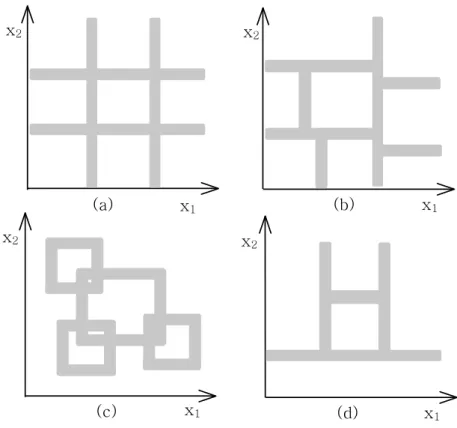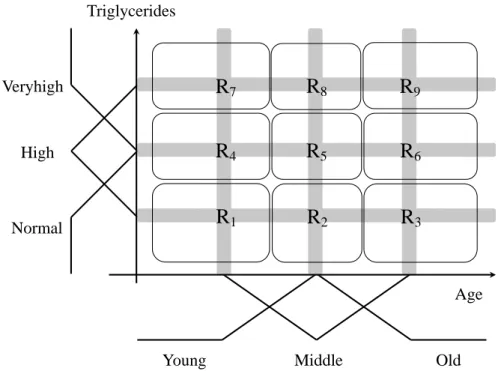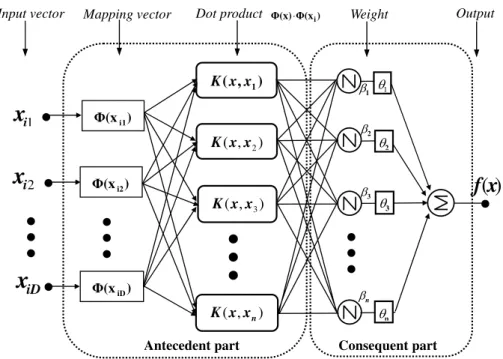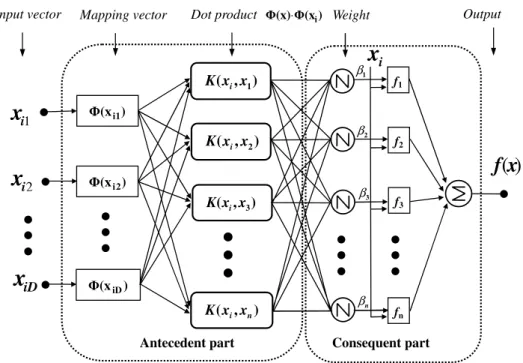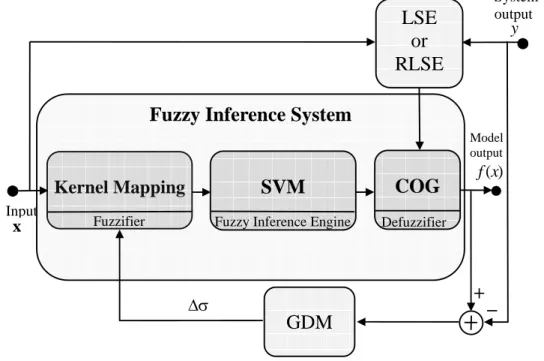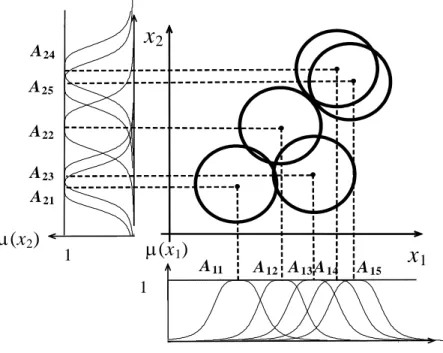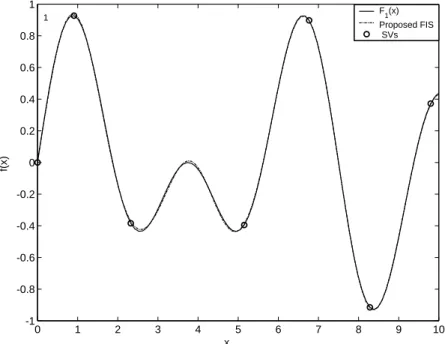Nonlinear Systems Using Kernel Machines
February 2007
Jongcheol Kim
A Study on the Fuzzy Modeling of Nonlinear Systems Using Kernel
Machines
Machines
by
Jongcheol Kim
School of Integrated Design Engineering KEIO UNIVERSITY
A thesis submitted to the Faculty of Science and Technology, Keio University in partial fulfillment of the requirements for the degree of Doctor of Philosophy in the School of Integrated Design Engineering
Yokohama, Japan 2007. 2. 1.
Approved by
Yasuo Suga Major Advisor
Abstract
This thesis presents new approaches to fuzzy inference system for modeling nonlin- ear systems based on input and output data using kernel machines. It is an impor- tant issue how to select the best structure and parameters of the fuzzy model from given input-output data. To solve this problem, this thesis proposes the state-of- the-art kernel machine as the fuzzy inference engine. The kernel machine contains two modules such as the machine learning and the kernel function. The machine learning is a learning algorithm. The kernel function projects input data into high dimensional feature space. In this thesis, an extended Support Vector Machine (SVM), an extended Feature Vector Selection (FVS) and an extended Relevance Vec- tor Machine (RVM) as kernel machines are used.
In the proposed fuzzy system, the number of fuzzy rules and the parameter val- ues of membership functions are automatically generated using extended kernel machines such as an extended SVM, an extended FVS and an extended RVM. The structure and learning algorithm of the FIS using an extended SVM, an extended FVS and an extended RVM are presented, respectively. The learning algorithm of the extended FVS is faster than the extended SVM. The extended FVS consists of the linear transformation part of input variables and the kernel mapping part. The linear transformation of input variables is used to solve problem selecting the best shape of the Gaussian kernel function. The extended RVM generates the smaller number of fuzzy rules than the extended SVM. The extended RVM does not need the linear transformation of input variables because the basis function of the extended RVM is not restricted within the limitation of the kernel function.
As the basic structure of the proposed fuzzy inference system, the Takagi-Sugeno (TS) fuzzy model is used. After the structure is selected, the parameter values in the consequent part of TS fuzzy model are determined by the least square estimation method. In particular, the number of fuzzy rules can be reduced by adjusting the
Some examples involving benchmark nonlinear systems are included to illustrate the effectiveness of the proposed techniques.
1 Introduction 1
1.1 Motivation . . . . 1
1.2 Previous Research . . . . 2
1.2.1 Partitioning of input space . . . . 3
1.2.2 Statistical techniques based neuro-fuzzy modeling . . . . 5
1.2.3 Kernel machines . . . . 5
1.3 Original Contributions . . . . 7
1.4 Thesis Overview . . . . 9
2 Preliminaries 11 2.1 Fuzzy Systems . . . 11
2.1.1 Fuzzy set and fuzzy logic . . . 11
2.1.2 Fuzzy inference system . . . 13
2.1.3 Takagi-Sugeno fuzzy model . . . 16
2.2 Statistical Learning Theory . . . 18
2.2.1 Generalization error . . . 18
2.2.2 Empirical risk minimization principle . . . 19
2.2.3 Structure risk minimization principle . . . 20
2.3 Kernel-Induced Feature Space . . . 21
i
CONTENTS ii
2.3.1 Learning in feature space . . . 21
2.3.2 Kernel function . . . 22
3 Fuzzy Inference System Using an Extended SVM 26 3.1 Introduction . . . 26
3.2 Support Vector Machines (SVM) . . . 27
3.3 New Fuzzy Inference System Using an Extended SVM . . . 31
3.3.1 The structure of the FIS using a SVM . . . 31
3.3.2 The structure of the FIS using an extended SVM . . . 34
3.3.3 The learning algorithm of the FIS using an extended SVM . . . 37
3.3.4 The input space partition of the FIS using an extended SVM . 39 3.4 Examples . . . 41
3.4.1 Example 1: modeling of 1-input nonlinear function . . . 41
3.4.2 Example 2: modeling of 2-input nonlinear function . . . 45
3.4.3 Example 3: modeling of 2-input nonlinear function . . . 49
3.5 Discussion and Conclusions . . . 54
4 Fuzzy Inference System Using an Extended FVS 55 4.1 Introduction . . . 56
4.2 Feature Vector Selection (FVS) . . . 57
4.3 New Fuzzy Inference System Using an Extended FVS . . . 60
4.3.1 The structure of the FIS using an extended FVS . . . 60
4.3.2 The learning algorithm of the FIS using an extended FVS . . . 63
4.3.3 The input space partition of the FIS using an extended FVS . . 65
4.4 Examples . . . 69
4.4.1 Example 1 : modeling of 2-input nonlinear function 1 . . . 69
4.4.2 Example 2 : modeling of 2-input nonlinear function 2 . . . 73
4.5 Discussion and Conclusions . . . 75
5 Fuzzy Inference System Using an Extended RVM 76 5.1 Introduction . . . 76
5.2 Relevance Vector Machine (RVM) . . . 78 5.3 New Fuzzy Inference System Using an Extended RVM . . . 81 5.3.1 The structure of the FIS using an extended RVM . . . 81 5.3.2 The learning algorithm of the FIS using an extended RVM . . . 84 5.3.3 The input space partition of the FIS using an extended RVM . 87 5.4 Examples . . . 87 5.4.1 Example 1 : modeling of 2-input nonlinear dynamic system . . 87 5.4.2 Example 2 : modeling of robot arm data . . . 94 5.5 Discussion and Conclusions . . . 102
6 Conclusions 104
Summary in Japanese 116
Summary in Korean 118
Curriculum Vitae 121
List of Figures
1.1 Various input space partitioning methods, (a) Grid partition, (b) Tree partition, (c) Scatter partition and (d) GA algorithm based partition . 4
2.1 Fuzzy rule vs input space partition . . . 14
2.2 Fuzzy reasoning for two rules with two antecedents . . . 16
2.3 The structure of a FIS . . . 17
2.4 Generalization error . . . 19
2.5 The relationship between approximation error, estimation error and generalization error . . . 22
2.6 Nonlinear mapping . . . 23
3.1 The ε-insensitive band and loss for linear and nonlinear regression problem . . . 29
3.2 The structure of the proposed FIS . . . 32
3.3 The simple structure of the proposed FIS using a SVM . . . 34
3.4 The structure of the proposed FIS using an extended SVM . . . 35
3.5 The learning algorithm of the proposed FIS using an extended SVM . 36 3.6 The input space partitions of the SVNN and the proposed FIS . . . 40
3.7 The structure of the FIS for modeling ofF1(x) . . . 42
3.8 The output results of the proposed FIS for modeling ofF1(x) . . . 43 iv
3.9 Performance results using four algorithms forF1modeling . . . 44
3.10 The structure of the FIS for modeling ofF2(x1, x2) . . . 46
3.11 The membership functions of the proposed FIS for modeling ofF2(x1, x2) 47 3.12 The output results of the proposed FIS with 5 rules for modeling of F2(x1, x2) . . . 48
3.13 The structure of the proposed FIS for modeling ofF3(x1, x2) . . . 49
3.14 Nonlinear functionF3(x1, x2)with 6 SVs . . . 50
3.15 The output results of the proposed FIS with 6 rules for modeling of F3(x1, x2) . . . 51
3.16 The membership functions of the proposed FIS for modeling ofF3(x1, x2) 52 3.17 Performance results using four algorithms forF3(x1, x2)modeling . . 53
4.1 The architecture of kernel function approximation procedure . . . 59
4.2 The structure of the proposed FIS using an extended FVS . . . 61
4.3 The learning algorithm of the proposed FIS . . . 64
4.4 The linear transformation of 2-D input variables . . . 67
4.5 The input space partitions of the FVS and the proposed FIS . . . 68
4.6 The structure of the FIS for the modeling ofF1(x1, x2) . . . 69
4.7 The membership functions of the proposed FIS for modeling ofF1(x1, x2) 71 4.8 The modeling result ofF1(x1, x2) . . . 72
4.9 The structure of the FIS for the modeling ofF2(x1, x2) . . . 73
4.10 The modeling result ofF2(x1, x2) . . . 74
5.1 The structure of the proposed fuzzy inference system . . . 82
5.2 The learning algorithm of the proposed FIS . . . 84
5.3 The input space partition of the proposed FIS using the RVM(a) and the extended RVM(b) . . . 86
5.4 The output data of dynamic system fore(k)≡0. . . 88
5.5 The number of RVs and prediction test error of the RVM and the FIS using the extended RVM when data sizes are generally large . . . 89
5.6 The structure of the proposed FIS for modeling ofy(k) . . . 90
LIST OF FIGURES vi
5.7 The comparison of input space partitions using the RVM(a) and the extended RVM(b) in training data of dynamic system with noises and found RVs(◦) . . . 91 5.8 The membership functionsy(k−1)andy(k−2)of the proposed FIS . 92 5.9 The estimated dynamic system output ofX(k) = [y(k−1), y(k−2)] . . 93 5.10 The number of RVs and prediction test error of the RVM and the FIS
using the extended RVM when training data of y1 (a) and y2 (b) are generally large . . . 95 5.11 The comparison of input space partitions using the RVM(a) and the
extended RVM(b) in training data ofy1 with noises and found RVs(◦) . 96 5.12 The comparison of input space partitions using the RVM(a) and the
extended RVM(b) in training data ofy2 with noises and found RVs(◦) . 97 5.13 The membership functions of the proposed FIS for modeling ofy1 . . . 99 5.14 The membership functions of the proposed FIS for modeling ofy2 . . . 100 5.15 The comparison of test robot arm data ofy1 (a) andy2 (b) and outputs
of the proposed FIS . . . 101
1.1 Various input space partition methods for fuzzy rule extraction . . . . 3
1.2 Compared results of SVM, FVS and RVM . . . . 7
2.1 The equivalence between isomorphic domains . . . 12
2.2 Kernel function and type . . . 24
3.1 Two passes in the learning algorithm for the proposed FIS . . . 37
3.2 The parameter values of the proposed FIS for modeling ofF1(x) . . . . 42
3.3 Compared results of modeling nonlinear functionF1(x) . . . 45
3.4 The parameter values of the proposed FIS for modeling ofF2(x1, x2) . 46 3.5 The compared results of modeling of nonlinear functionF2(x1, x2) . . 48
3.7 The compared results of modeling of nonlinear functionF3(x1, x2) . . 50
3.6 The parameter values of the FIS for modeling ofF3(x1, x2) . . . 51
4.1 The parameter values of the FIS for modeling ofF1(x1, x2) . . . 70
4.2 The compared results of nonlinear functionF1(x1, x2) . . . 72
4.3 The parameter values of the FIS for modeling ofF2(x1, x2) . . . 74
4.4 The compared results of nonlinear functionF2(x1, x2) . . . 75
5.1 The parameter values of the FIS for modeling ofX(k) = [y(k−1), y(k−2)] 89 5.2 The compared results of nonlinear dynamic function . . . 93
vii
LIST OF TABLES viii
5.3 The parameter values of the FIS for modeling ofy1. . . 98 5.4 The parameter values of the FIS for modeling ofy2. . . 98 5.5 The compared results of the modeling robot arm datay1 andy2 . . . . 102
CHAPTER
1
Introduction
1.1 Motivation
Conventional mathematical modeling approaches have difficulty in modeling many systems because of the lack of exact knowledge, highly nonlinear behaviors or per- formance limitation.
To overcome this problem, the neuro-fuzzy system has been popularly developed for modeling of nonlinear systems based on input and output data [1] [2] [3] [4]
[5] [6]. The advantage of integrating neural networks and fuzzy inference system (FIS) is that neuro-fuzzy systems are able not only to describe target systems us- ing fuzzy logic and reasoning of fuzzy system but also to decide its parameters us- ing the learning and adaptive capability of neural network. Generally, neuro-fuzzy modeling from numeric data consists of two parts that are structure identification and parameter identification. The process of structure identification determines the number of fuzzy rules or variables selection. The process of parameter identi- fication decides the parameters of membership functions in antecedent parts and coefficients of linear equations in consequent parts.
However, if training data set for learning has measurement noise and (or) avail- able data size is too small in the real system modeling, neural network can bring
1
1.2. PREVIOUS RESEARCH 2
out over-fitting problem which is a factor of poor generalization. It is an important problem to select the optimal structure of the neuro-fuzzy model for good general- ization, such as the number of fuzzy rules, parameters of membership functions and coefficients in consequent part.
In this thesis, we propose new approaches to FIS for modeling nonlinear system based on input and output data using kernel machines such as an extended Support Vector Machine (SVM) [7], an extended Feature Vector Selection (FVS) [8] and an extended Relevance Vector Machine (RVM) [9].
The proposed FIS performs system optimization and generalization simultane- ously. As the basic structure of the proposed fuzzy inference system, the Takagi- Sugeno (TS) fuzzy model [10] is used. In the proposed fuzzy system, the number of fuzzy rules and the parameter values of membership functions are automatically generated. In addition, the number of fuzzy rules can be reduced by adjusting the linear transformation matrix or the parameter values of kernel functions using a gradient descent method. After the structure fuzzy system is determined, the pa- rameter values in the consequent parts of TS fuzzy model are determined by the least square estimation method.
1.2 Previous Research
The main issue in neuro-fuzzy modeling is how to decide the best structure and parameters from a given input-output data of the particular systems, such as the number of fuzzy rules, parameters of membership functions in antecedent parts and coefficients in consequent parts. If a fuzzy model has too many rules, it de- creases the error between a given data output and fuzzy model output, but can cause overfitting and decrease computational power. By contrast, if a fuzzy model has too small rules, it increases computational power and prevents overfitting but can increase error.
The conventional structure identification of neuro-fuzzy modeling is closely re- lated to the partitioning of input space for fuzzy rule generation.
Table 1.1Various input space partition methods for fuzzy rule extraction
Group Method Disadvantage
Partition
Grid Partition Course of dimensionality
Tree Partition Number of rule exponential in- creasing
Scatter Partition Completeness not guaranteed GA Algorithm based Parti-
tion
Long learning time
Clustering
Fuzzy C-mean Clustering Predetermined the number of clustering
Mountain Clustering Let perception grid points as the candidate for clustering center Hybrid Clustering Depending on implementation
1.2.1 Partitioning of input space
There are two kinds of groups for fuzzy rule generation from the data such as parti- tion and clustering as shown in Table 1.1. One group is the partition of input space.
The partition of input space can be categorized into the following methods.
• Grid Partition[11] [12] : As shown in Fig. 1.1(a), input space is divided into grid partition using grid type.
• Tree Partition[13] : As shown in Fig. 1.1(b), each region is uniquely specified along a corresponding decision tree.
• Scatter Partition [14] : As shown in Fig. 1.1(c), scatter partition is illus- trated as the subset of the whole input space.
• GA Algorithm based Partition [15] : As shown in Fig. 1.1(d), GA Algo- rithm based partition is presented as the partition method using GA algorithm which divides the input space into disjoint decision areas.
The other group is the clustering of input space. The clustering method is classi- fied into the following methods.
• Fuzzy C-mean Clustering [16] : Fuzzy C-mean clustering partitions the collection ofnvectorxj,(j = 1, ..., n)intoC groupsGi,(i= 1, ..., c)and finds a
1.2. PREVIOUS RESEARCH 4
x1 x2
(a)
x1 x2
x1 (d) x2
(c)
x1 x2
(b)
Fig. 1.1Various input space partitioning methods, (a) Grid partition, (b) Tree par- tition, (c) Scatter partition and (d) GA algorithm based partition
cluster center in each group such that a cost function of dissimilarity measure is minimized.
• Mountain Clustering [17] : Mountain clustering is a relatively simple and effective approach to approximate estimation of cluster centers on the basis of a density measure.
Table 1.1 summaries various input space partitioning methods for fuzzy rule extraction and these disadvantages. The conventional partition of input space in structure identification is separated from parameter identification determining the value of parameter. Besides this process is isolated system optimization involving parameter and structure optimization. In particular, partition methods have disad- vantages, which include the course of dimensionality [11], an exponential increase in the number of rules [13], unpredictable completeness [14] or computation cost
[15]. In clustering techniques, the number of cluster must be known in advance [16] [18] , or previously settled grid points of grid lines can function as candidates for cluster centers [17] [19]. Traditional sequential learning approaches of struc- ture identification and parameter identification are adequate for off-line learning instead of on-line learning [20].
1.2.2 Statistical techniques based neuro-fuzzy modeling
Recently, the state-of-the-art kernel machine has actively applied to various fields [21] [22] [23] [24] [25] [26] [27]. The kernel machine is derived from the statistical learning theory. The kernel machine contains two modules such as the machine learning and the kernel function. The machine learning is a learning algorithm.
The kernel function projects input data into high dimensional feature space to in- crease the computational power.
In kernel machine, the most popular method is Support Vector Machine (SVM).
The SVM [21] has delivered good performance in various application. In particular, the SVM has been used in order to find the number of network nodes or fuzzy rules based on given error bound [28] [29] [30]. The Support Vector Neural Network (SVNN) was proposed to select the appropriate structure of radial based function network for the given precision [28]. Support vector learning mechanism for fuzzy rule-based inference system was presented in [29].
However, these methods have same Gaussian kernel parameters, completeness is not guaranteed. It means that the number of fuzzy rules is not really simplified.
In this thesis, the number of rules is reduced by adjusting the parameter values of membership functions using a gradient descent algorithm during the learning process. Once a structure is selected, the parameter values in consequent part of TS fuzzy model are determined by the least square estimation method.
1.2.3 Kernel machines
The kernel machine is the large class of learning algorithms with kernel function.
The kernel machine generally deals with trade-off between fitting the training data and simplifying model capacity. Recently, kernel machines have been popularly used in many applications including face recognition [31] [32] [33] [34], bioinfor-
1.2. PREVIOUS RESEARCH 6
matics [35] [36] [37], text categorization [38] [39], time series analysis [40] [41] [42]
[43], machine vision [44] [45], signal processing [46] and nonlinear system identifi- cation [47] [48].
As kernel machines, Support Vector Machine (SVM), Feature Vector Selection (FVS) and Relevance Vector Machine (RVM) are noticeable methodologies. These kernel machines are summarized as follows:
Support Vector Machine (SVM) [21]
The SVM has strong mathematical foundations in statistical learning theory. It is a learning system designed to trade-off the accuracy obtained particular training set and the capacity of the system. The structure of the SVM is the sum of weighted kernel functions. The SVM determines support vectors and weights by solving a linearly constrained quadratic programming problem in a number of coefficients equal to the number of data points. The SVM is generally divided into Support Vector Classification (SVC) [49] and Support Vector Regression (SVR) [50].
Feature Vector Selection (FVS) [26]
The FVS is based on kernel method. It performs a simple computation optimizing a normalized Euclidean distance into the feature space. The FVS technique is to select feature vector being a basis of data subspace and capturing the structure of the entire data into feature space. Once the feature vector is selected, the output of FVS is calculated using a kernel function approximation algorithm. The FVS is also used for classification [37] and regression [26].
Relevance Vector Machine (RVM) [27]
The RVM has an exploited probabilistic Bayesian learning framework. It acquires relevance vectors and weights by maximizing a marginal likelihood. The structure of the RVM is described by the sum of product of weights and kernel functions.
The kernel function means a set of basis function projecting the input data into a high dimensional feature space. The RVM is also presented for classification and regression.
Table 1.2Compared results of SVM, FVS and RVM
SVM FVS RVM
Sparsity Bad Middle Good
Generalization Good Bad Good
Computation time Middle Short Long Flexibility of kernel No No Yes
Now, we compare the characteristics of the SVM, FVS and RVM. The compared results are listed in Table 1.2.
In sparsity, the number of the extracted support vectors grows linearly with the size of training set. On the contrary, the RVM achieves sparsity because the poste- rior distributions of many of weights are sharply peaked around zero. The FVS has middle sparsity because it extracts feature vector as a basis of data subspace. Both SVM and RVM deal with the generalization, but the FVS do not achieve generaliza- tion. The RVM has long computation time because it has orderO(M3) complexity with the M number of basis function. Because the SVM solves the quadratic pro- gramming problem, the computation time of SVM is longer than the FVS. Both SVM and FVS must the Mercer’s condition of kernel function. It means that the kernel function is symmetric positive finite definite. But contrast, because the RVM has only basis function as kernel function, it’s kernel function does not need to satisfy the Mercer’s condition.
In following chapters, we will present SVM, FVS and RVM in detail, respectively.
1.3 Original Contributions
In this thesis, we describe new approaches to fuzzy inference system (FIS) for mod- eling nonlinear systems based on input and output data using kernel machines. As the basic structure of the proposed fuzzy inference system, the Takagi-Sugeno (TS) fuzzy model is used.
We have the following original contributions in the areas of fuzzy modeling using the state-of-the-art kernel machines, such as the extended Support Vector Machine (SVM) [7], the extended Feature Vector Selection (FVS) [8] and the extended Rele-
1.3. ORIGINAL CONTRIBUTIONS 8
vance Vector Machine (RVM) [9].
• We propose the FIS using an extended SVM for modeling the nonlinear sys- tems. In the proposed FIS, the number of fuzzy rules and the parameter values of fuzzy membership functions are automatically generated using an extended SVM. In particular, the number of fuzzy rules can be reduced by adjusting the parameter values of the kernel functions using the gradient descent method.
• We propose the FIS using an extended FVS for modeling the nonlinear sys- tems. In the proposed FIS, the number of fuzzy rules and the parameter val- ues of fuzzy membership functions are also automatically determined using an extended FVS. In addition, the number of fuzzy rules can be reduced by ad- justing the linear transformation matrix of input variables and the parameter values of the kernel function using the gradient descent method.
• We propose the FIS using an extended RVM for modeling nonlinear systems with noise. In the proposed FIS, the number of fuzzy rules and the parame- ter values of fuzzy membership functions are automatically decided using an extended RVM. In particular, the number of fuzzy rules can be reduced under the process of optimizing a marginal likelihood by adjusting parameter values of kernel functions using the gradient ascent method.
The kernel machine already works fine system modeling from input and out- put. However, there are several advantages of the proposed FIS using the extended SVM, FVS and RVM, respectively.
• The SVM, FVS and RVM describe only input and output of system as black- box. It is difficult to make out interior state of system. On the contrary, be- cause the FIS describes system using if-then rules with membership functions qualitatively, it can help us to grasp the system.
• Once the black-box system is presented as the FIS, it is easy to design the controller. As an example, the well known parallel distributed compensation (PDC) can be utilized [51].
• If we model the nonlinear system as TS fuzzy model, we can prove the stability of system [52].
1.4 Thesis Overview
This thesis presents the fuzzy inference systems of nonlinear systems using ker- nel machines such as the extended Support Vector Machine (SVM), the extended Feature Vector Selection (FVS) and the extended Relevance Vector Machine (RVM).
Each of the original contributions described in the previous section is presented in the following separated chapters.
Chapter 1describes the background, motivation, contribution and the outline of this work.
Chapter 2 describes the preliminaries of the fuzzy system, statistical learning theory and kernel-induced feature space. In particular, the fuzzy set and logic, fuzzy reasoning and Takagi-Sugeno fuzzy model in fuzzy system are introduced. In sta- tistical learning theory, generalization error, empirical risk minimization and struc- ture risk minimization principle are presented. In kernel-induced feature space, learning in feature space and kernel function are described.
Chapter 3 describes the fuzzy inference system using an extended SVM. The extended SVM is introduced as fuzzy inference engine. The structure and learning algorithm of the FIS using an extended SVM are proposed. The proposed FIS is tested in three numerical examples.
Chapter 4 describes the fuzzy inference system using an extended FVS. The extended FVS is also proposed as fuzzy inference engine. The learning algorithm of the extended FVS is faster than the extended SVM. The extended FVS consists of the linear transformation part of input variables and the kernel mapping part.
The linear transformation of input variables is used to solve problem selecting the best shape of the Gaussian kernel function. The proposed FIS is evaluated in the examples of two nonlinear functions.
Chapter 5 describes the fuzzy inference system using an extended RVM. The extended RVM is also proposed as fuzzy inference engine. The extended RVM gen- erates the smaller number of fuzzy rules than the extended SVM. The extended
1.4. THESIS OVERVIEW 10
RVM does not need the linear transformation of input variables because the basis function of the extended RVM is not restricted within the limitation of the kernel function. The structure and learning algorithm of the FIS using an extended RVM are presented. The proposed FIS is evaluated in the examples of nonlinear dynamic systems and robot arm data.
Chapter 6 summarizes the results of this thesis and discusses future research initiatives.
CHAPTER
2
Preliminaries
This chapter introduces fuzzy system, statistical learning theory and kernel-based feature space. In fuzzy system, fuzzy set and fuzzy logic are presented. The Takagi- Sugeno (TS) fuzzy model known as one of the most outstanding fuzzy systems is also introduced. In statistical learning theory, generalization error, empirical and structure risk minimization principle are presented. In kernel-based feature space, learning in feature space and the properties of kernel function are illustrated.
2.1 Fuzzy Systems
A fuzzy system is a rule-based system that uses fuzzy set and fuzzy logic to reason about data. Fuzzy logic is a computational paradigm that provides a mathematical tool for representing information in a way that resembles human linguistic commu- nication and reasoning processes [53] [54] [55] [56] [57] [58] [59] [60].
2.1.1 Fuzzy set and fuzzy logic
Lotfi Zadeh established the foundation of fuzzy logic in a seminal paper entitled
“Fuzzy Sets” [61]. In [61], fuzzy sets were imprecisely defined as sets and classes
“play an important role in human thinking, particularly in the domains pattern 11
2.1. FUZZY SYSTEMS 12
Table 2.1The equivalence between isomorphic domains
Set Logic Algebra
Membership Truth Value
Member (∈) True (T) 1 Non-member False (F) 0
Intersection (∩) AND (∧) Product(×)
Union (∪) OR (∨) Sum (+)
Complement (−) NOT (∼) Complement (0)
recognition, communication of information, and abstraction.” Fuzzy sets are the generalization of crisp sets with crisp boundaries.
Let us now basic definitions concerning fuzzy sets.
Definition 2.1.1 [55] [62] If X is a collection of objects denoted generically by x, then afuzzy setA in a universe of discourse X is defined as a set of ordered pairs:
A={(x, µA(x))|x∈X} (2.1)
whereµA(x)is called themembership function (MF) for the fuzzy set A. The MF is a mapping
µA(x) :X−→[0,1]. (2.2)
Note that each element of X is mapped to a membership grade between 0 and 1.
The operation that assigns a membership function µA(x) to a given value x is calledfuzzification.
The most commonly used membership functions are triangular, trapezoidal, Gaus- sian, generalized bell and sigmoidal MFs.
The rules of FIS are expressed as the logical form ofif ... thenstatements. J. M.
Mendel pointed out fuzzy logic system as “It is well established that propositional logic is isomorphic to set theory under the appreciate correspondence between com- ponents of these two mathematical system. Furthermore, both of these systems are isomorphic to a Boolean algebra.” [55] [63]. Some of the most important equivalence between these isomorphic domains are shown in Table 2.1.
In fuzzy domains, fuzzy operators are needed such as crisp operators. The follow- ing fuzzy operators most commonly used in the frame of fuzzy systems [55] [62].
Operators for intesection/AND operations (µA∩B(x) = µA(x)∧ µB(x)): The intersection/AND of two fuzzy sets A and B is defined as the following T-norm oper- ators,
minimum : min(µA(x), µB(x)) algebraic product : µA(x)·µB(x)
bounded product : max(0, µA(x) +µB(x)−1) drastic product :
µA(x) , ifµB(x) = 1 µB(x) , ifµA(x) = 1
0 , ifµA(x), µB(x)<1.
Operators for union/OR operations(µA∪B(x) =µA(x)∨µB(x)): The union/OR of two fuzzy sets A and B is defined as the following T-conorm operators,
maximum : max(µA(x), µB(x))
algebraic sum : µA(x) +µB(x)−µA(x)·µB(x) bounded sum : min(1, µA(x) +µB(x))
drastic product :
µA(x) , ifµB(x) = 0 µB(x) , ifµA(x) = 0
1 , ifµA(x), µB(x)>1.
Operators for complement/NOT(µA(x) = µ∼A(x)): The complement/NOT of fuzzy sets A is defined as the following fuzzy complement,
f uzzy complement : 1−µA(x) 2.1.2 Fuzzy inference system
Zadeh pointed out that conventional techniques for system analysis are intrinsically suited for dealing with humanistic systems [64]. Zadeh introduced the concept of linguistic variable as an alternative approach to modeling human thinking.
In fuzzy inference system, fuzzy if-then rules have the form [62],
ifxisA thenyisB, (2.3)
where A and B are linguistic values defined by fuzzy sets on universes of discourse X and Y, respectively. The input condition “x is A” is called theantecedentorpremise.
The output assignment “y is B” is called theconsequentorconclusion.
2.1. FUZZY SYSTEMS 14
High Veryhigh
Young Middle Old
Triglycerides
Age
Normal R1
R4
R2 R3
R5 R6
R7 R8 R9
Fig. 2.1Fuzzy rule vs input space partition
The generation of fuzzy if-then rules is related to the partitioning of input space partition. Figure 2.1 shows the example of the 2-dimensional input space parti- tioning [55]. In Fig. 2.1, the fuzzy linguistic variable Age has three membership functions:Young,MiddleandOld. The fuzzy linguistic variableT riglycerideshas also three membership functions: Normal,HighandVeryhigh. The total number of fuzzy rules is nine as shown in Fig. 2.1.
The 9-th fuzzy rule is described as follows:
R9 : If AgeisOld and T riglyceridesisV eryhigh,
Then Cardiac riskisDangerous. (2.4)
whereDangerousis linguistic fuzzy output variable.
In fuzzy inference system, fuzzy reasoning is necessary. Fuzzy reasoning is an inference procedure that derives a reasonable output and conclusion from a set of fuzzy if-then rules and known facts.
The inference procedure of fuzzy reasoning (approximate reasoning) is defined as follows:
Definition 2.1.2 [62] Let A, A’ and B be fuzzy sets of X, X and Y, respectively. As- sume that the fuzzy implication A−→B is expressed as a fuzzy relation R on X×Y.
Then the fuzzy set B’ induced by “x is A0” and the fuzzy rule “if x is A then y is B” is defined by
µB0(y) = A0◦R=A0◦(A−→B)
= maxxmin[µA0(x), µR(x, y)]
= ∨x[µA0(x)∧µR(x, y)] (2.5) where a composition operator◦means themax−mincomposition.
The fuzzy implication A −→ B is defined as commonly operators, minimum and product. The most of composition operators have used themax−mincomposition or themax−productcomposition.
The output of FIS is crisp value. The process that extracts the best crisp output from a fuzzy output as a representative value is called defuzzification. Many de- fuzzification methods have been developed in literature. The most commonly have used method is theCenter of Gravity (COG), also calledCenter of Areas(COA) or Centroid.
Given an output fuzzy setA = µA(x)defined in the universe X of the variablex, the defuzzified outputyis given as follows:
• Center of Gravity(COG):
yCOG = R
XµA(x)x dx R
XµA(x)dx (2.6)
whereµA(x)is the aggregated output MF.
Figure 2.2 shows graphically the operation fuzzy reasoning for two rules with two antecedents. Two fuzzy if-then rules with two antecedents are presented as follows:
R1 : ifxisA1 andyisB1 thenzisC1,
R2 : ifxisA2 andyisB2 thenzisC2, (2.7) Two firing strength µAi(x) and µBi(y) (i = 1,2) indicate degrees to which the an- tecedent part of the fuzzy rule is satisfied. They are calculated usingANDoperator
2.1. FUZZY SYSTEMS 16
µA1 µB1 µC1
R1
x y z
Min
µA2 A2 µB2 B2 µC2 C2
R2
x x y0 y z
µC
z
0
Max µC1(Z)
A1 B1 C1
µC2(Z)
Fig. 2.2Fuzzy reasoning for two rules with two antecedents
(min(µAi(x), µBi(x))). Two induced consequent membership functions µC1(z) and µC2(z))are combined usingUnionoperator(max(µC1(z), µC2(z))). Once fuzzy rea- soning is achieved, defuzzifer follows.
The basic structure of a fuzzy system consists of four conceptual components as shown in Fig. 2.3 (1) a knowledge base, which consists of a database that de- fines the membership functions used in the fuzzy rules, a rule basethat contains a selection of fuzzy rules; (2) afuzzifier, that translates crisp inputs into fuzzy val- ues; (3) an inference engine, which applies the fuzzy reasoning mechanism; (4) defuzzifier, that extracts a crisp value from fuzzy output.
2.1.3 Takagi-Sugeno fuzzy model
Fuzzy Inference System (FIS)s have powerful capability for modeling complex non- linear systems [1] [10] [16]. One of the most outstanding FISs, proposed by Takagi and Sugeno [10] [57], is known as the TS model. The TS fuzzy model consists of fuzzy if-then rules which map the input space into fuzzy regions and approxi-
Fuzzifier Inference engine Defizzifier Crisp
Input
Knowledge base
Crisp Output Fuzzy
output Fuzzy
input
Database Rule base
Fig. 2.3The structure of a FIS
mate the system in every region by a local model corresponding to various operat- ing points. The structure of TS fuzzy model is the combination of interconnected systems with linear models.
The TS fuzzy model suggested a systematic approach for generating fuzzy rules from a given input and output data set. This fuzzy model is presented as follows:
R1 : Ifx1 isM11and ... andxD isM1D, Then f1=a10+a11x1+· · ·+a1DxD R2 : Ifx1 isM21and ... andxD isM2D,
Then f2=a20+a21x1+· · ·+a2DxD ... ... ...
Rn : Ifx1 isMn1 and ... andxD isMnD,
Then fn=an0+an1x1+· · ·+anDxD. (2.8) wherenis the number of fuzzy rules,Dis the dimension of input variables,xj(j = 1,2, ..., D)is an input variable,fiis thei-th local output variable,Mij(i= 1,2, ..., n, j=
2.2. STATISTICAL LEARNING THEORY 18
1,2, ..., D)is a fuzzy set andaij(i= 1,2, ..., n, j= 0,1, ..., D)is a consequent parame- ter.
The final output of TS fuzzy model is obtained as follows:
f(x) = Pn i=1
wifi Pn i=1
wi ,
= Pn i=1
wi(ai0+ai1x1+ai2x2+· · ·+aiDxD) Pn
i=1
wi
,
= XD
j=0
hiaijxj,
where x0 = 1,
hi= wi Pn i=1
wi
, wi = YD
j=1
Mij(xj), (2.9)
wi is the weight of the i-th If-then rule for input and Mij(xj) is the membership grade ofxj inMij.
Sugeno-Kang proposed the procedure of TS fuzzy modeling as a nonlinear mod- eling framework. The methods of structure and parameter identifications were in- troduced. These methods had influence on the self-organizing fuzzy identification algorithm (SOFIA) [59] and neuro-fuzzy modeling techniques [1] [60].
2.2 Statistical Learning Theory
In this section, we introduce a statistical learning theory. Recently, statistical learn- ing theory has been popularly developed in many application [21] [22] [23] [24] [25]
[49] [50].
2.2.1 Generalization error
Generalization error is the sum of estimation error and approximation error as shown in Fig. 2.4 [65].
2.2. STATISTICAL LEARNING THEORY 19
● ●
●
Approximation error
Generalization error Estimation error
Hypothesis space
Target space
f0
fl
fˆl
Fig. 2.4Generalization error
• Approximation error is the one due to approximation from hypothesis space into target space.
• Estimation error is the one due to the learning procedure which results in a technique selecting the non-optimal model from the hypothesis space.
2.2.2 Empirical risk minimization principle
In statistical learning theory, the standard way to solve the learning problem is to define risk function, which measures the average amount of error associated with an estimator [66].
• Classical Regularization Networks
V(yi, f(xi)) = (yi−f(xi))2 (2.10)
• Support Vector Machines Regression
V(yi, f(xi)) =|yi−f(xi)|² (2.11)
